How to prepare beds for garlic before winter: step-by-step instructions for beginning farmers and advice from experienced colleagues
Who doesn’t dream of a rich harvest on their plot? It rarely happens that a gardener has almost no effort to do this. Often only fruitful work leads us to the expected result. And if a gardener has set himself the goal of growing garlic, he should take care of this in the fall. If you do everything right, you will get a good harvest in mid-summer.
Let's look at what it means to prepare a bed for garlic in the fall.
Preparing land and beds for autumn planting of garlic
The basic conditions for an abundant and high-quality garlic harvest are the correct choice of location and adherence to agricultural technology in preparing the beds and soil. Before you prepare the soil, you need to choose a place for the future bed and determine the acidity of the soil. This is important to understand whether additional soil preparation is needed before planting.
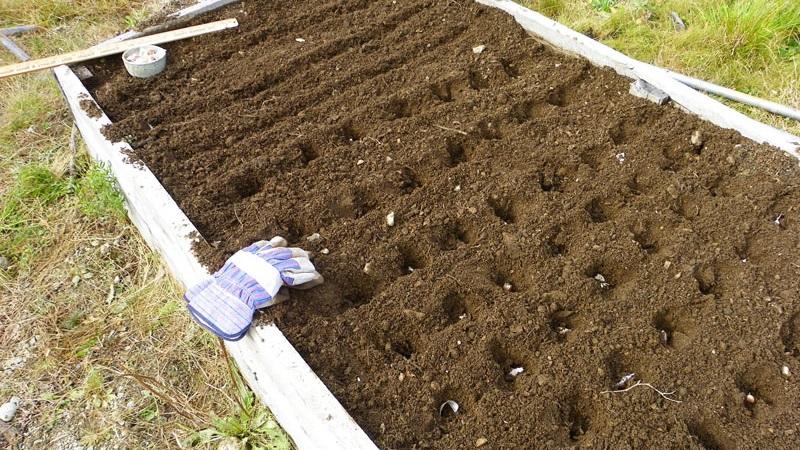
Determining the landing site
The ideal option for a bed of winter garlic is a sunny plot of the garden., preferably on a hill so that spring meltwater does not flood the crop. The correct location of the bed is in the north-south direction.
Attention! An important point is the fertility of the soil and its acidity level. Garlic is planted only after certain crops.
If you plant a crop without knowing this rule, you may end up with a small, weak and diseased harvest.
Determination of soil acidity
In an acidic environment, plants cannot absorb vital minerals., and it often happens that novice agronomists, even if they strictly follow all the rules, do not get the expected result. What is soil acidity? Soil with a lack of lime and an abundance of hydrogen ions is unsuitable for the growth of plant crops.
To determine the acidity of the soil, use an acid meter. To do this, make a small depression in the ground and clear a fragment of the area from debris, stones, branches and roots. Pour distilled water into the recess. As soon as the water turns the color of the soil, lower the probe into it for 60 seconds. After this, the soil acidity level will appear on the display. The normal acid-base balance of the soil is 3.5-5.5 units. A higher value indicates that the soil is unsuitable for planting crops.
Important! To determine the acidity of the soil with an acid meter, only distilled water is suitable, since it has a neutral environment. Do not touch the acid meter probe or the water in the well with your hands, as this will distort the result.
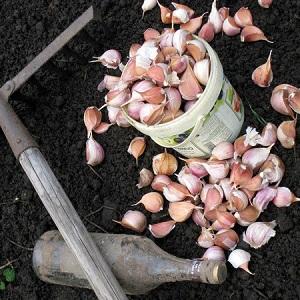 If there are no special devices at hand, soil acidity level is determined by other methods:
If there are no special devices at hand, soil acidity level is determined by other methods:
- several blackcurrant leaves brewed with boiling water;
- for the most common weeds;
- using table vinegar.
If there is high acidity in the area, there is no point in expecting a good harvest.. The soil will have to be deoxidized - limed. They do this in several passes. When deep digging a site, dry calcium hydroxide (“fluff”), chalk, dolomite flour, wood ash, green manure or slaked lime are added to the soil once every two years. With each subsequent treatment, the concentration of additives is reduced. If the soil acidity in the area is uneven, deacidification is carried out zonally.
Timing for planting winter garlic in the fall
Planting period crops in the ground depends on the expected planting depth:
- If you plan to plant garlic at 3-5 cm (which is most often done), then sow it 2-3 weeks before the first frost. In the central European zone of Russia, this period, as a rule, falls at the end of September - beginning of October, and in the southern regions - a month later.
- Garlic planted 10-15 cm deep takes root better and tolerates cold more easily. In the middle regions it is planted from the end of August, and in the south, accordingly, a month later.
Tillage
Before planting garlic for the winter, the soil must be properly prepared in advance.
Algorithm:
- Soil preparation. In the period from the second half of August to mid-September, the soil is fertilized. For every 1 sq. m of beds, apply a mixture of 10 kg of humus, 2 tbsp. wood ash, 1 tbsp. chalk, 2 tbsp. l. sodium sulfate and 1 tbsp. l. superphosphate. The mixture is evenly distributed over the selected area, then the soil is dug up to a depth of at least 2/3 of a shovel. This depth will allow the soil to be well saturated with useful minerals.
- Forming a bed. Its optimal size for winter garlic is up to a meter wide. The site must be raised 20 cm above the level of the site so that excess moisture does not reach the roots, which can cause rotting of the crop.
- Must be given time for soil to shrink after digging. When there is little rainfall, the bed is watered several times.
Advice. There is no need to rush and plant garlic in a freshly dug garden bed. As the soil settles, the seeded material ends up deeper in the soil and takes longer to germinate in the spring.
The next stage of preparing the bed is treating the soil against pests.. Disinfection is carried out after the soil shrinks.
Soil disinfection
 The earth is treated with a solution copper sulfate (1%). Dilute 1 tbsp. l. substances in a bucket of water and water the garden bed. For 1 sq. m of bed, half a bucket of solution is enough. After this, cover the soil with film.
The earth is treated with a solution copper sulfate (1%). Dilute 1 tbsp. l. substances in a bucket of water and water the garden bed. For 1 sq. m of bed, half a bucket of solution is enough. After this, cover the soil with film.
1-2 days before the expected planting of the crop You need to scatter urea on the surface of the bed at a rate of 15-20 g per 1 square meter. m plot and water the soil with water.
Various preparations are used to disinfect soil.. "Fitosporin" and "Topsin-M" effectively resist the formation and spread of fungus. Insecticides with an antiseptic effect, such as Acrobat and Ridomil Gold, disinfect the soil from many pests, but they need to be used in combination with other drugs.
It will be interesting:
How to cover garlic for the winter, how and when to do it
To treat the soil before planting garlic, The following solutions are suitable:
- Copper sulfate solution. Add 2 tbsp to a bucket of water. l. substances. This amount is enough for 2 square meters. m beds.
- Strong solution of potassium permanganate. Manganese crystals are gradually poured into a bucket of water and mixed thoroughly. Manganese is added until the color of the liquid becomes crimson with dissolved crystals. It is important not to overdo it with crystals - excess substance will spoil the soil.
- Bordeaux mixture. 100 g of the substance is diluted in a bucket of water (this is approximately 5 tbsp.). This amount of solution is enough for 1.5-2 square meters. m beds.
- Multicomponent solution. To prepare it, 10 g of copper sulfate and the same amount of boric acid are diluted in a bucket of water.Manganese is added until the solution acquires a light crimson hue.
- Complex solution based on copper sulfate. Dissolve 1 tbsp in a liter of hot water. l. copper sulfate, poured into a bucket. Additionally, 1 tbsp is dissolved in the same amount of cold liquid. l. soda and the same amount of ammonia. This solution is poured into a bucket with a solution of copper sulfate, cold water is added to make the bucket full.
Disinfecting solutions are evenly applied to the surface soil using a watering can.
Fertilizers during planting
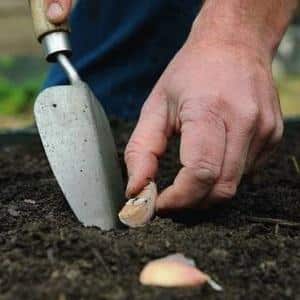 Before winter sets in, the planted seeds must take root.. For this they need phosphorus and potassium. Tilling the land before planting a crop involves adding fertilizer while digging.
Before winter sets in, the planted seeds must take root.. For this they need phosphorus and potassium. Tilling the land before planting a crop involves adding fertilizer while digging.
Use compost, humus or mineral mixtures:
- wood ash diluted with water at the rate of 1 liter of substance per bucket of water;
- phosphate rock (used no more than once every 3 years);
- solution of superphosphate with water (the mixture is prepared according to the instructions on the label).
It is allowed to apply mineral fertilizers simultaneously with compost.. To better saturate the soil with nutrients, it is better to use fertilizers in liquid form.
What kind of manure to apply under garlic
Do not use fresh humus for garlic, since the ammonia it contains is dangerous for the developing root system. It is better to add compost in combination with wood ash, phosphorites or two-year-old humus. But even here it is important to maintain proportions so as not to cause harm. 1 liter of the complex mixture is diluted in a bucket of water and distributed over 2 square meters. m beds.
Mineral fertilizers for garlic
When choosing mineral fertilizers, it is important that they do not exceed the nitrogen ratio. Superphosphate contains 8% nitrogen substances, so it can be used.
The following complex mixtures are also used:
- "Nitroammophoska";
- two-component mixtures with a predominance of potassium and phosphorus;
- "Azofoska" winter type.
It is better to fertilize the soil under garlic with a liquid mixture.
How to prepare garlic for planting in the fall
Winter garlic propagates in three ways: seeds, cloves and bulbs. Only tines are suitable for autumn planting. Over the winter, the planting material takes root, and by July large heads grow.
Seed preparation algorithm:
- Calibration From the available winter garlic, the largest dried heads that are not affected by rot and other diseases are selected.
- Selection of teeth. Carefully separate each head of garlic into cloves, choosing only the largest ones for planting. If there is little planting material, the existing teeth are sorted by size. Subsequently, they will also need to be planted - in groups. This is necessary for uniform germination. If the onion has 3 or 4 cloves, even if they are the largest, it is better to leave such a head for food. Such pathology indicates the degeneration of culture. Also, you should not leave affected teeth for planting.
- Preparing the cloves. The bottom of each tooth is removed for rooting. This must be done as carefully as possible so as not to damage the shell of the clove, immediately before the next stage of preparation.
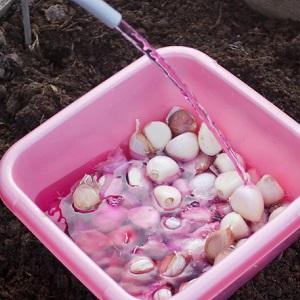 Seed treatment. A week before the intended planting, the prepared teeth are soaked for 24 hours in a weak solution of potassium permanganate. Ash liquor or copper sulfate is also used for this purpose.
Seed treatment. A week before the intended planting, the prepared teeth are soaked for 24 hours in a weak solution of potassium permanganate. Ash liquor or copper sulfate is also used for this purpose.
Pre-soaking planting material strengthens plant immunity against fungal infections and other microorganisms.
Immediately before planting, the seed is soaked in saline solution (3 tablespoons of substance per half bucket of water) for 2-3 minutes. Next, soak the garlic in a solution of copper sulfate (1 tablespoon per bucket of water) for 1-2 minutes in order to disinfect the material.
Reference. The vitriol solution is then used for pre-planting treatment of the beds.
Instead of copper sulfate, a solution of manganese, ash infusion or "Fitosporin-M". The cloves are kept in such solutions for at least half an hour.
Planting winter garlic
The time for planting garlic depends on the depth to which the cloves are placed in the soil.. The deadlines are quite flexible, the main thing is to have time to do everything 40 days before the onset of the first frost. This period is quite enough for the garlic to take root and then successfully withstand the winter cold. If you plant a crop earlier, it may germinate before frost and the future harvest will be spoiled.
First, prepare a bed for garlic for winter.. Planting locations for crops are marked on the site. Furrows are made, the depth of which depends on the planting of the crop. This is approximately 5-6 or 13-15 cm. The distance between the furrows should not exceed 20 cm, and from the sides of the bed - 5 cm. A small layer of a mixture of ash, potassium salt and superphosphate with coarse sand is poured into the furrows. Then the bed is watered with a slightly pink solution of potassium permanganate.
More about garlic:
Planting winter garlic to a depth of 10-15 cm
In the middle zone, where winter conditions are more severe, garlic is planted to a depth of 10-15 cm. This depth allows the crop to grow a good root system in order to safely withstand the cold.The cloves are placed in the ground with the sharp part at the top at a distance of 10-15 cm from each other, slightly deeper into the ground.
Advice. When planting, you can lay the teeth on the side. There is an opinion that garlic will overwinter better this way.
1-2 weeks after planting, humus is added to the garden bed. or peat no more than 2 cm thick.
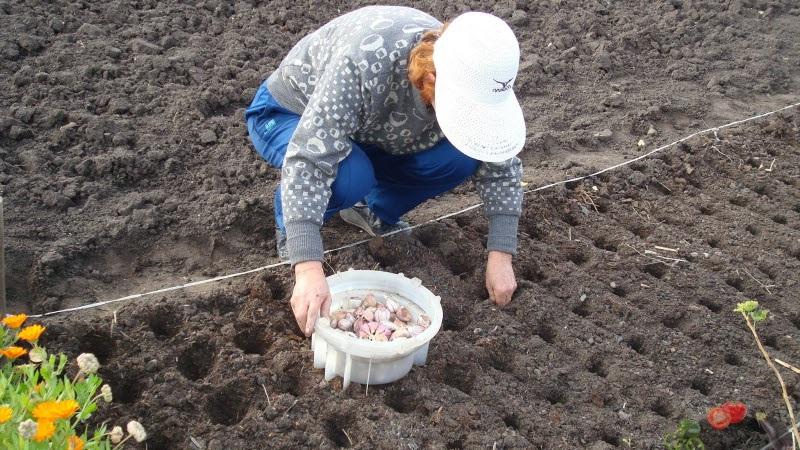
Planting garlic before winter to a depth of 3-5 cm
This method is practiced in the southern regions of the country. This depth will be enough for the garlic to take root and survive the winter cold. Planting material is placed in the grooves with the bottom down, slightly deepening each clove. The distance between the cloves is 12-15 cm.
Further steps for both landing options are identical.. Bury the beds with rotted compost. The peculiarity is that simply filling in the furrows and leveling the bed is not enough. It is necessary to create a dense layer of soil, since loose soil will quickly be washed away by precipitation. Buried beds should be compacted slightly.
In the northern regions and middle zone, mulching of beds is mandatory. This procedure is necessary to warm the crop and further fertilize the soil. The mulch layer is approximately 10 cm. Ideal for this purpose are pine needles, peat, leaves, humus, wood ash, a mixture of soil with sawdust or dry manure, in general, any plant debris.
Reference. In the southern regions it is not necessary to mulch the beds.
The last stage - warming winter garlic. This is done at sub-zero temperatures. Snow is considered the best “blanket” for winter crops. If the area is well-ventilated, you can put temporary fences around the perimeter of the bed to prevent the snow from being blown away by the wind. Cover the beds with spruce branches, spunbond or dry branches.
What vegetables can be predecessors of garlic?
 Winter garlic needs soil saturated with organic fertilizers. This is ensured by previous cultures.
Winter garlic needs soil saturated with organic fertilizers. This is ensured by previous cultures.
It is better to plant garlic after:
- cucumbers;
- tomatoes;
- legumes;
- early cabbage;
- pumpkins;
- zucchini.
It is not recommended to plant garlic after potatoes, turnips, radishes, carrots or onions.
Useful tips
To get a high-quality harvest, follow all recommendations. Beginning summer residents often make basic mistakes, due to which they ultimately do not get the expected result.
Common mistakes:
- The location of the bed is below. Due to excess moisture, the heads will rot.
- Planting time is one of the key points. The crop should be planted when the nights have already become cold and the days remain warm.
- Insufficient insulation. If the garden bed is not covered with enough snow in winter, the garlic will freeze.
- The shoots must be removed, otherwise all the nutrients will not remain in the head, but will go into the air bulbs.
- In spring and summer, do not forget about watering and fertilizing.
Conclusion
Garlic is considered one of the most unpretentious crops, and if all recommendations for planting and care are followed correctly, then by summer you will receive a bountiful and high-quality harvest. And you can see clearly how to prepare the beds for planting crops, how to cultivate the soil and how to grow garlic correctly - further in the video.
NOT sodium sulfate, but potassium sulfate. pH 3.5, definitely need to add dolomite